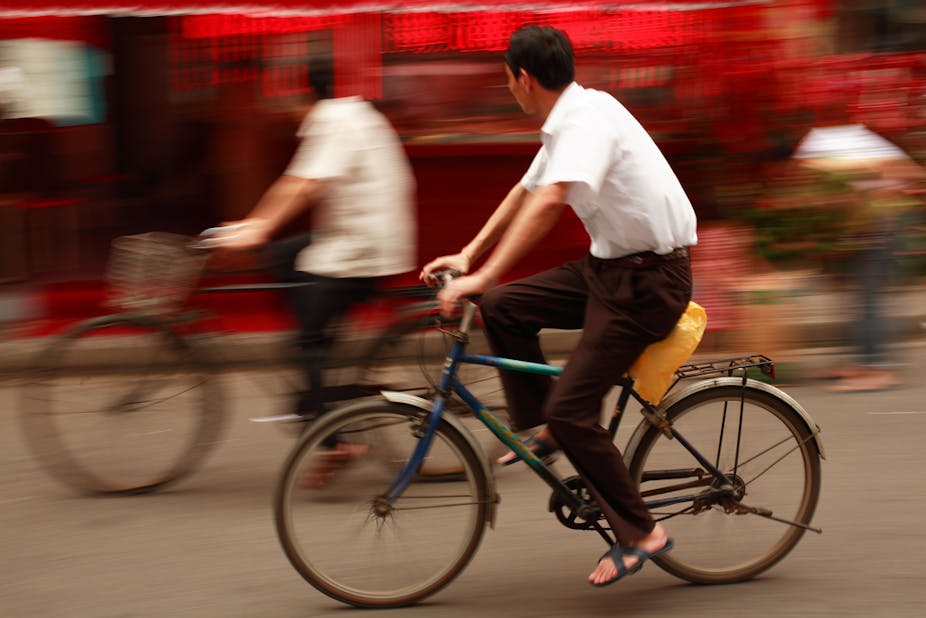CYCLING IN AUSTRALIA: I’m living in the middle suburbs of Shanghai – a great cycling metropolis. Bike-riding rates are 30 to 40 times higher than Australian cities.
Hardly anyone wears lycra or rides a mountain or racing bike here. Cycling is all about “effortless” propulsion at low speeds on cheap, upright city bicycles in everyday clothes. People ride at half the speed of my mates in Australia, never breaking a sweat.
Everyone rides here: grandmothers, professors, street sweepers, office workers, my guitar teacher, children. It is these “missing” bicycle riders we don’t see in Australia. Those going to the shop, the train station or the pub on a bicycle, instead of walking or driving a short distance.
So how do we target these groups?
We are certainly going in some good directions with bicycle policies and programs in many of Australia’s major cities, turning back 60 years of disinvestment in cycling. But how do we take the next step?
Here are some suggestions, based on comparative experiences and tied to practical policy changes.
John Pucher and Ralph Buehler’s analysis of cycling across countries demonstrates that by putting dollars into cycling infrastructure, supporting it with sensible policies, restraining cars from their worst excesses, and encouraging cycling in practical ways, cities make riding “irresistible”.

Australian cities are now making tentative starts on this agenda. Off-road and on-road networks are being built, especially in the inner-cities. Bicycle parking is more common. “Share the road” and similar education campaigns are in use.
But have you ever noticed how much of Australia’s cycling policy, programs, projects and culture is focused on long-distance and high-speed cycling? There is little attention to low-speed, everyday, short-hop bicycle riding.
We have a thriving sports cycling scene in Australia (all hail Cadel!). And we have a burgeoning group of long-distance commuters willing to ride heroic distances to work. But these are not the people you see in most “cycling cities”.
How do we make Australian cities more like Shanghai? How do we get people riding as part of their everyday habits? How do we make cycling normal?
For starters, infrastructure is critical.
Every arterial road built in Shanghai includes a bicycle lane, usually barricaded from cars. This makes a continuous network of safe routes right across the urban area.

Many state and local governments have adopted similar policies in Australia, albeit without the barricades, and much new infrastructure is coming from this enlightened stance.
But guess who has no such policy? Infrastructure Australia. This means the only part of government not willing to spend 0.5% or less of its urban road budget on ensuring a viable future cycling network is our federal government.
Secondly, low street speeds make for safer bicycle riding in Shanghai.
China has clearly got issues with dangerous driver and rider behaviour. But trauma rates are lower than one might expect as traffic speeds are low on suburban streets; usually around 30km/h.
At this speed, cars, motorcyclists and bike riders have more time to negotiate in traffic. The accidents that might occur at higher speeds just don’t happen, and the collisions that do occur (I’ve seen a couple) are usually benign.
The 50km/h posted street speed limit in local streets in Australia, and 40km/h in school zones, are therefore an international embarrassment, set way higher than norms in cities such as Berlin.
Thirdly, is it only me, or are Australian bicycle shops too daunting for the prospective rider who just wants a cheap trundler for going down to the shop and back? They’re full of the accoutrements of Australian cycling culture’s obsessions with speed and gleaming high-end technical machinery. Look in the shop window and there’s a $10,000 racing machine staring back at you.

In Shanghai bike shops often cater only to those wanting a cheap low-speed bike. They are staggeringly normal places, bereft of weird clothing, bike computers, training manuals and the other gear we find in Australia. Cycling is normal.
Effortless cycling relies on different bikes too. In Shanghai most have chain-guards, mudguards, baskets and rear racks. There are cheap folding bikes you can put in your apartment, small wheeled machines and classic old-school bikes.
Mountain bikes dominate sales in Australian discount department stores. But they are not the design of choice for effortless riding. Without a chain guard they chew your trousers, almost forcing you to wear special “cycling” clothes.
Shanghai has electric bicycles (e-bikes) by their millions. These are less safe than a motorcar, despite being speed regulated to only 20km/h, but are more sustainable. The safer versions of the e-bike are banned from use in Australia under current road rules. These rules need urgent review.
Finally, the experience of the UK’s Cycling Cities and Towns initiative suggests focusing effort on a specific urban area will have more impact on ridership than scattergun investment.
The Queensland Government’s (Transport and Main Roads 2011) pilot “active towns” project concentrates resources on only one location. There will be significant interest in how this affects cycling participation rates in involved cities such as Mackay.
If this approach is successful in the Australian context, as it has been in the UK, then expect the model to be more widely applied.
The next evolution in our thinking and our practices must be towards effortless cycling. Adopting these ideas may get us further towards that agenda.
Read the rest of the Cycling in Australia series.

